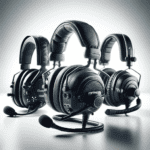Introduction
Choosing the right headset is vital to enhance your audio experience, whether you are an avid gamer, a music enthusiast, or someone who spends hours on calls. A high-quality headset can transport you to a world of immersive sound, allowing you to fully appreciate the nuances of every note or the subtle soundscape of your favorite games.
Conversely, a poor-quality headset can dampen your enjoyment and leave you feeling frustrated with distorted audio or uncomfortable fit. Understanding the key features and considerations when purchasing a headset is essential in making an informed decision.
With countless options available in the market today, it can be overwhelming to navigate through specifications and technical jargon. That’s why we have created this comprehensive buying guide: to help you demystify the world of headsets and empower you with knowledge that will enable you to choose the perfect headset for your needs.
Importance of Choosing the Right Headset

The importance of selecting the right headset cannot be overstated. Whether you plan on using it for gaming, listening to music, watching movies, or making professional calls, a high-quality headset ensures that every auditory detail is reproduced accurately and faithfully. It allows you to fully immerse yourself in whichever activity brings joy and fulfillment into your life.
A premium-grade headset not only provides exceptional sound quality but also offers comfort during extended wear. The right fit ensures that it remains snugly attached without causing any discomfort or fatigue that could distract from your overall experience.
Overview of the Buying Guide
In this buying guide, we will explore all aspects necessary for choosing the ideal headset. We’ll delve into different types of headsets available in today’s market – over-ear headsets, on-ear headsets, and in-ear headsets (also known as earbuds) – discussing their advantages, disadvantages, and best use cases. Understanding the different types will enable you to identify the one that suits your preferences and lifestyle.
Next, we will explore the various sound quality considerations. We’ll dive into frequency response range, explaining how it impacts sound quality and how to select an optimal range for different music genres.
We’ll also discuss impedance, its effect on audio output, and the recommended impedance levels for various devices such as smartphones and laptops. Additionally, we will explore noise cancellation technology options available in headsets.
Understanding Headset Types
Over-ear headsets
Over-ear headsets are a popular choice for many audio enthusiasts due to their immersive sound quality and comfortable design. These headsets feature ear cups that encompass the entire ear, creating a seal that blocks out external noise and enhances overall sound experience. One of the key advantages of over-ear headsets is their ability to deliver powerful, deep bass response, making them ideal for those who enjoy bass-heavy music genres such as hip hop or electronic.
In addition to superior sound quality, over-ear headsets also provide excellent comfort for extended wear. The large ear cups distribute the weight evenly around the ears and reduce pressure on sensitive areas.
Moreover, they often incorporate soft padding on the headband and ear cups, further enhancing comfort during long listening sessions or gaming marathons. When it comes to best use cases, over-ear headsets excel in situations where noise isolation is crucial.
They are particularly suitable for studio recording purposes or environments with high ambient noise levels. Additionally, gamers who immerse themselves in virtual worlds can benefit from these headsets as they offer an immersive experience with exceptional audio fidelity.
On-ear headsets
On-ear headsets provide an alternative option for those who prefer a more portable and lightweight design compared to over-ear models. As the name suggests, these headphones rest directly on the ears rather than enveloping them completely. This design choice offers certain advantages worth considering.
The first advantage of on-ear headsets is their compact size and portability. Their smaller footprint makes them easier to carry around without compromising audio quality significantly.
Furthermore, many on-ear models come with foldable mechanisms or swiveling ear cups that enhance portability even further. However, it is important to note that the on-ear design may not provide the same level of noise isolation as over-ear counterparts.
This means that external sounds can still seep in, which could be a drawback in noisy environments. On the other hand, this feature can be advantageous in situations where some awareness of your surroundings is necessary.
Best use cases for on-ear headsets include commuting or traveling scenarios where portability and convenience are key. They are also well-suited for individuals who prioritize a more natural sound experience without sacrificing too much external noise awareness.
In-ear headsets (earbuds)

In-ear headsets, commonly referred to as earbuds, have gained immense popularity due to their compact size and versatility. These small headphones are designed to fit directly into the ear canal, providing a snug fit and effective noise isolation. The main advantage of in-ear headsets lies in their portability and convenience.
Their lightweight design allows for easy storage and carrying without compromising audio quality. Additionally, many models offer various sizes of interchangeable ear tips to ensure a comfortable and secure fit for different users.
Despite their small size, modern in-ear headsets can deliver impressive sound quality with good clarity across different frequency ranges. However, it is important to note that they might not match the audio depth or bass response provided by over-ear or on-ear counterparts.
Best use cases for in-ear headsets include activities such as exercising or commuting where compactness and mobility are essential. They are also popular choices among smartphone users who value portability during calls or listening to music on-the-go.
Sound Quality Considerations
Frequency response range: Analyzing the Melodic Spectrum
When it comes to sound quality, one cannot underestimate the significance of frequency response range. This term refers to the spectrum of frequencies a headset can reproduce, measured in Hertz (Hz).
The wider the frequency response range, the greater the ability of the headset to capture both low and high-frequency sounds. A broader range allows for a more immersive listening experience as it enables you to perceive subtle nuances in music or enjoy thunderous explosions in games and movies.
To optimize your audio experience, it’s important to consider the ideal frequency range for different types of music genres. For instance, genres like classical and jazz demand accurate reproduction across a wide frequency spectrum, including delicate highs and resonant lows.
In contrast, bass-heavy genres such as hip-hop or EDM can benefit from headsets that emphasize lower frequencies without compromising on clarity. Therefore, understanding a headset’s frequency response range helps you choose one that aligns with your preferred music genres.
Impedance: Unraveling Sonic Resistance
Impedance is another crucial factor influencing audio output quality. It refers to the measure of opposition that an electrical circuit presents to an alternating current flowing through it—measured in ohms (Ω).
A higher impedance means greater resistance and requires more power to achieve optimal volume levels. When considering impedance values for headsets, it’s essential to match them with compatible devices such as smartphones or laptops.
Low-impedance headsets are typically suited for portable devices like smartphones or tablets since they require less power for optimum performance. High-impedance headsets are better suited for dedicated sound systems or professional audio equipment that can provide sufficient amplification.
Noise Cancellation Technology: The Battle against Unwanted Distractions

In today’s bustling world, noise cancellation technology has become a sought-after feature. Understanding the different types of noise cancellation helps you make an informed choice when selecting a headset.
Active noise cancellation (ANC) employs built-in microphones to detect external sounds and generate anti-noise signals that cancel out unwanted noise. This technology is highly effective in reducing ambient sounds like traffic or airplane engines, offering a peaceful listening experience.
On the other hand, passive noise isolation relies on physical barriers, such as well-fitted ear cups or ear tips, to block out surrounding noises. When it comes to ANC technology, various brands have made significant strides in recent years.
Notable advancements include adaptive ANC that adjusts according to your surroundings and transparency modes that allow you to hear important external sounds without removing your headset. Considering these improvements can help you identify the best noise-cancellation technology available in the market for an uninterrupted audio escapade.
Comfort and Ergonomics Features
Headband design
Balancing Support and Flexibility When it comes to headset comfort, the design of the headband plays a crucial role.
Headsets typically offer two main options: adjustable and fixed headbands. Adjustable headbands provide the advantage of customization, allowing users to find the perfect fit for their unique head size and shape.
By adjusting the length of the headband, users can achieve optimal comfort by distributing pressure evenly across their head. On the other hand, fixed headbands are set at a specific size and do not offer flexibility in adjustment.
Furthermore, it is important to consider the impact of headband material on overall comfort. The choice of material can significantly affect how comfortable a headset feels during long listening sessions.
Many high-end headsets feature padded or cushioned headbands that provide softness and reduce pressure points on top of the skull. This padding helps prevent discomfort caused by prolonged wear, making it an essential consideration for those who plan to use their headset for extended periods.
Ear cup design
Finding the Perfect Fit Ear cups are another critical aspect when evaluating headset comfort levels.
There are two popular materials used for ear cups: memory foam and leatherette. Memory foam ear cups have gained popularity due to their ability to conform to the shape of an individual’s ears, providing a snug fit that enhances both comfort and noise isolation properties.
The memory foam molds itself around your ears, creating a seal that minimizes sound leakage while reducing external noise interference – perfect for immersive gaming experiences or focused audio sessions. Alternatively, leatherette ear cups offer different advantages in terms of durability and breathability.
These synthetic leather coverings provide a smooth surface against your skin while maintaining an excellent seal around your ears. Additionally, they tend to be less sensitive to temperature changes compared to memory foam, making them comfortable even in warm environments.
For those who prioritize breathability, certain headsets incorporate special airflow features within the ear cups to prevent excessive heat and moisture build-up during long listening sessions. Weight distribution is a vital consideration for extended wear.
Headsets that evenly distribute their weight across the headband and ear cups reduce strain and discomfort over time. By ensuring balanced weight distribution, manufacturers can alleviate pressure on sensitive areas such as the top of the skull or outer ears, allowing users to enjoy their audio experience without unnecessary distractions.
Connectivity Options
Wired vs. Wireless Headsets – When it comes to connectivity options for headsets, the two main contenders are wired and wireless solutions. Each option has its own set of advantages and disadvantages that should be considered before making a decision.
Wired headsets offer a direct connection to your audio source, ensuring a stable and uninterrupted signal transmission. They are generally known for delivering superior sound quality due to the absence of compression or interference that can occur wirelessly. Additionally, wired headsets are often more affordable than their wireless counterparts and do not require charging or battery replacements. On the other hand, wireless headsets provide the convenience of unrestricted movement without being tethered to your device.
This freedom is especially valuable for gamers or individuals who like to move around while listening to music or engaging in phone calls. Furthermore, many wireless headsets now offer advanced features like built-in microphones, touch controls, and even virtual assistants integration.
Best Connectivity Option Based on Usage Scenarios
Finding the Perfect Match for Your Needs Determining the best connectivity option between wired and wireless headsets largely depends on your specific usage scenarios and priorities. For audiophiles seeking uncompromised sound quality without any interference issues, wired headsets remain an excellent choice.
They are perfect for critical listening sessions at home or in professional studios where audio fidelity is paramount. Conversely, if convenience and freedom of movement take precedence over absolute sound quality, then wireless headsets become an ideal choice.
Whether you’re working out at the gym, commuting around town, or simply prefer a clutter-free experience while gaming or watching movies, wireless technology enables seamless mobility without sacrificing much audio performance. When considering which connectivity option suits your needs best, it’s crucial to weigh these advantages against their respective drawbacks in order to make an informed decision.
Wireless Technologies
Exploring the Boundaries of Wireless Connectivity Wireless headsets rely on various technologies for seamless audio transmission. The most prevalent wireless technologies in the headset market include Bluetooth, RF (Radio Frequency), and proprietary wireless protocols.
Each technology comes with its own nuances and features. Bluetooth is the most widely adopted wireless technology due to its compatibility with a vast array of devices, including smartphones, tablets, and computers.
It provides efficient power consumption and offers reasonable sound quality when paired with high-quality codecs such as aptX or LDAC. RF-based headsets, on the other hand, typically offer a longer range and better resistance to interference but may require a dedicated dongle for connectivity.
Some manufacturers also develop their own proprietary wireless protocols to optimize performance specifically for their headsets. These protocols often boast lower latency, higher fidelity, or additional features unique to their products.
When choosing between wired and wireless headsets, it’s imperative to consider your needs regarding sound quality, convenience, mobility requirements, and budget constraints. Both options have distinct advantages that cater to different scenarios.
Additionally, advancements in wireless technology have bridged the gap between wired and wireless audio experiences significantly over recent years. So whether you opt for wired or embrace the freedom of wireless connectivity, rest assured that there is a perfect headset out there to meet your preferences and elevate your listening experience.
opt for wired or embrace the freedom of wireless connectivity, rest assured that there is a perfect headset out there to meet your preferences and elevate your listening experience.









